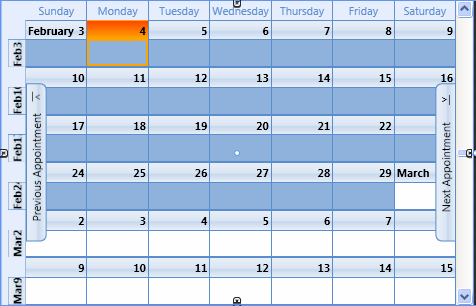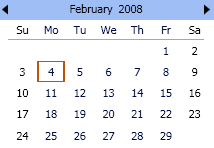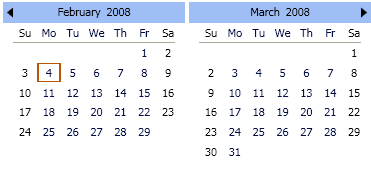ComponentOne Scheduler for WPF consists of the following controls and components, which provide all of the functionality for a scheduling application:
The C1Scheduler Control
The C1Scheduler control is a fully functional schedule that allows users to add, edit, and manage their appointments. It is composed of two main parts:
• A storage area that contains business data, such as appointments, contacts, and so on, with an ability to bind this data to database storages like DataSet, and provides business logic for this data. The storage is referenced by the DataStorage property and is represented by the C1ScheduleStorage root class. The object model of C1ScheduleStorage is the same for all ComponentOne scheduling tools for different platforms, such as WinForms and ASP.NET.
• The default C1Scheduler interface, which is intended to help in building an arbitrary user interface for data managed by C1Scheduler.

The C1MonthCalendar Control
The C1MonthCalendar control is used to create a one-month calendar user interface, in XAML, allowing users to select a specific date interactively.

The C1MultiMonthCalendar Control
The C1MultiMonthCalendar control is used to create a calendar, in XAML, showing multiple months and allowing users to select a specific date interactively.

The C1DateTimePicker Control
The C1DateTimePicker control is used in C1Scheduler embedded forms for selecting dates and times from drop-down controls.
![]()
The C1ScheduleStorage Component
The C1ScheduleStorage component handles all of the data operations for the C1Scheduler control. Users do not have to create the C1ScheduleStorage component from the code, as it is automatically created by the C1Scheduler control.
The C1ScheduleStorage component contains specific data storages for appointments, resources, contacts, labels, and statuses, which work on the data layer to provide data to the scheduling application. The C1ScheduleStorage component contains some separate data storages as listed in the following table:
|
Data Storage |
Description |
|
Storage for appointment data. | |
|
Storage for category data. | |
|
Storage for contact data. | |
|
Storage for label data. | |
|
Storage for status data. | |
|
Storage for resource data. |
When providing data to these storages, it is necessary to specify mappings between data fields in the datasource and their interpretation in the storage.
All storages are inherited from BaseStorage class, which provides all the basic functionality required for data binding. To bind a storage to a specific data table (or another data object) it is necessary to set its DataSource and DataMember properties, and then set the mappings for the properties to corresponding data fields in the bound datasource. For example, if the bound data source contains a field called EmployeeName, you should set the ContactStorage.Mappings.TextMapping.MappingName property to the name of this field.
The BaseStorage component has almost the same functionality as the System.Windows.Forms.BindingSource component, but does not depend on System.Windows.Forms namespace.
Note: The CategoryStorage, LabelStorage and StatusStorage storages contain a predefined set of standard items.
 Scheduler for WPF Design-Time Support
Scheduler for WPF Design-Time Support
 Assigning Values to a Nested Property
Assigning Values to a Nested Property
 Adding Localized Resources to a Project
Adding Localized Resources to a Project
|
